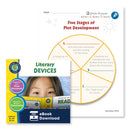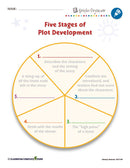Description
**THIS IS AN INSTANT DOWNLOAD**
This FREE worksheet includes 1 page from our Literary Devices title.
The Five Stages of Plot Development in a Story, Movie, or Play Graphic Organizer is a large circle that has been divided into five parts. It looks like a pie that has been sliced into five pieces. Beginning at the top of the circle and continuing clockwise, each part is numbered and has a fill-out line with a description of a particular stage of plot development. The numbers show what happens first in the plot of a story, what happens second, and so forth. Your job is to put the name of each stage on the correct line. This worksheet can be used on its own, or paired with the individual resource. And the best part is, it's FREE.
************************************************************************
About the full resource, Literary Devices:
Explore the language of storytelling and discover the meaning and purpose of literature with Literary Devices. Definitions of important terms and many opportunities to practice the skills being taught make our resource user-friendly and easy to understand. Examine the fundamental devices that make up any story, starting with characterization. Break down a character into their simple parts: dialog, appearance, thoughts, actions, and reactions. Take a look at the time, place and conditions of a story. Learn how setting can help establish the mood or atmosphere. Use graphic organizers to map out the plot. Find out how a story unfolds with the rising action, climax and resolution. Next, dissect a story's main purpose by identifying its theme and point of view. Aligned to your State Standards and written to Bloom's Taxonomy, reproducible writing tasks, crossword, word search, comprehension quiz and answer key are also included.
This FREE worksheet includes 1 page from our Literary Devices title.
The Five Stages of Plot Development in a Story, Movie, or Play Graphic Organizer is a large circle that has been divided into five parts. It looks like a pie that has been sliced into five pieces. Beginning at the top of the circle and continuing clockwise, each part is numbered and has a fill-out line with a description of a particular stage of plot development. The numbers show what happens first in the plot of a story, what happens second, and so forth. Your job is to put the name of each stage on the correct line. This worksheet can be used on its own, or paired with the individual resource. And the best part is, it's FREE.
************************************************************************
About the full resource, Literary Devices:
Explore the language of storytelling and discover the meaning and purpose of literature with Literary Devices. Definitions of important terms and many opportunities to practice the skills being taught make our resource user-friendly and easy to understand. Examine the fundamental devices that make up any story, starting with characterization. Break down a character into their simple parts: dialog, appearance, thoughts, actions, and reactions. Take a look at the time, place and conditions of a story. Learn how setting can help establish the mood or atmosphere. Use graphic organizers to map out the plot. Find out how a story unfolds with the rising action, climax and resolution. Next, dissect a story's main purpose by identifying its theme and point of view. Aligned to your State Standards and written to Bloom's Taxonomy, reproducible writing tasks, crossword, word search, comprehension quiz and answer key are also included.






